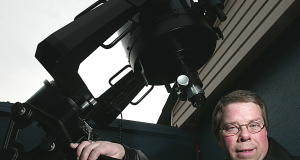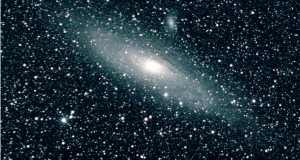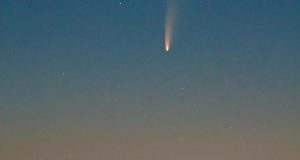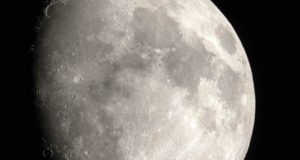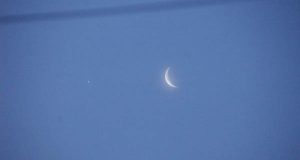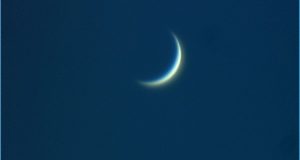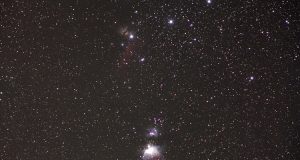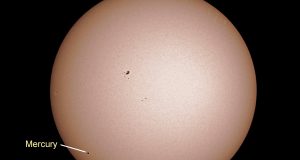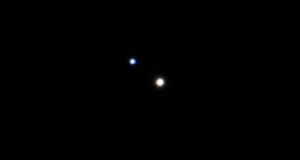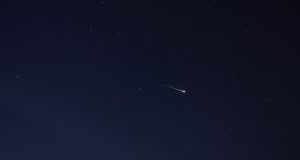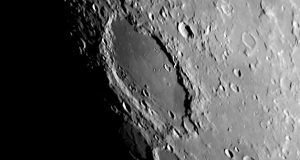Over the past decades, we have witnessed and embraced the advancement of technology in cars, TVs, computers and cell phones. The list goes on and on. We have the opportunity to learn anything via reputable websites over the internet as well as YouTube videos. Although technology has changed, the night sky has appeared the same for countless millennia. Back ...
Read More »Author Archives: Gary Boyle
Mars the Red Planet
Over the past few months, the planet Mars has been steadily brightening and is now at its peak. While it takes Earth 365 days to orbit once around the sun, Mars lies farther away from the sun taking 687 days to complete one lap. Every 26 months and an odd number of days, Earth catches up with slower Mars, ...
Read More »Spotting A Galaxy
Looking up at a clear sky is something we do naturally, whether you are taking a late-night stroll, walking the dog or just relaxing on the deck. Without the aid of binoculars or a telescope, our eyes have a difficult time seeing faint celestial objects that reside in the universe. We do see simple bright objects like the moon ...
Read More »Comet Neowise
A bright comet is now in the evening sky and you can see it without a telescope. Comet F3 (NEOWISE) has been a fantastic object in the early morning pre-dawn sky but will be well placed below the Big Dipper to see and photograph over the next couple of weeks and hopefully into August. I have been following and ...
Read More »International Astronomy Day – May 2
The study of astronomy has been around for some 5,000 years and is regarded as the oldest of the allied sciences. Over time, the constellations were created by seeing shapes using a handful of stars appearing close together such as Ursa Major or the Big Dipper. By connecting these stellar dots, celestial shapes came in the form of a person, ...
Read More »Stargazing – A Way To Destress
As we try to cope with the Covid-19 crisis, we must find ways to reduce stress levels and anxiety. Aside from listening to online music and reading books, try stepping outside on a clear night and drink in the night sky. The celestial landscape had been the entertainment of civilizations for thousands of years before the invention of the telescope ...
Read More »Evening Beacon
Throughout history, keen skywatchers would follow the weekly and monthly movement of bright objects against the background sky. The early Greeks referred to the planets of our solar system as the “wanderers” and there are five which can be seen and followed with the unaided eye. The planet Venus is now seen high in the western sky shortly after sunset. ...
Read More »Starbirth
The stars we see on a clear night have been burning for millions or billions of years. But how did they come to be? Stars, like our sun, are created from vast interstellar clouds of gas and dust called a nebula. These stellar objects can measure more than a hundred light-years in length. Over time smaller clouds in the ...
Read More »Mercury to Transit the Sun – November 11 – UPDATED
Nov 13, 2019 @ 08:01 A wonderful video of Mercury transiting the sun on November 11th was shared to Vimeo. The video was shot from NASA’s Solar Dynamics Observatory and shows the transit more than 22,000 miles above Earth. Nov 6, 2019 @ 08:03 Mercury is the closest planet from the sun and orbits once every 88 days. ...
Read More »Seeing Double
Seeing double is never a good thing and a sign to seek medical attention; however, double stars can be a thing of beauty. Some stars that appear as a single point of light to the unaided eye are in fact, double when magnified with binoculars or a telescope. Optical doubles are two stars that appear close together only by line ...
Read More »Perseid’s are underway
The annual Perseid meteor shower is currently underway and will peak on the night of August 12 into the morning of the 13th. The Perseids is the result of earth ploughing through the debris field of Comet Swift-Tuttle when this 26-kilometre wide mountain of rock and ice last rounded the sun in 1992. At its peak, the shower can produce up ...
Read More »The Annual Perseid Meteor Shower
You are taking a late-night stroll or sitting on your deck staring at the starry sky and whoosh, a quick streak of light catches your attention. You have just witnessed the fiery re-entry of space debris called a meteor. In a few cases, they can be nuts, bolts and wires from damaged satellites orbiting high above the earth. However, ...
Read More »Big Bright Jupiter
On any clear night, look to the southern portion of the sky after sunset and you will come across a bright object. This is not a star but the planet Jupiter. Of the eight major planets in our solar system, Jupiter is literally the “king”. This fifth planet from the sun is so large; eleven earths can line up across ...
Read More »Telescopes and Binoculars
Telescopes have come a long way since its invention in 1608. The simple refracting telescope consisted of two small lenses located at each end of a long tube. This `spyglass` was a great tool to magnify approaching enemy ships from a distance. Galileo Galilei heard of this new instrument and in 1609 constructed his own without seeing the original. ...
Read More »Our Moon
Stargazing is a wonderful and peaceful past time that anyone can enjoy. From planets to star clusters, galaxies to nebulae, the night sky is a treasure chest of celestial delights. Although astronomy and star gazing are traditionally done in the dark countryside, our glorious moon can be enjoyed from the city as well. The moon was created about 50,000 ...
Read More » Wawa-news.com You can't hear the 'big picture'!
Wawa-news.com You can't hear the 'big picture'!
